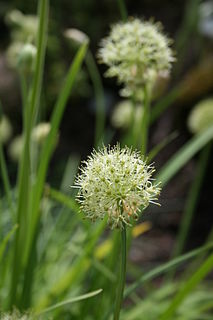Allium chrysocephalum is a plant species native to China, in the provinces Gansu, Qinghai, and Sichuan. It grows at elevations of 3400–4800 m.
Allium dentigerum is a plant species native to Gansu and Shaanxi Provinces in China. It grows on slopes and in pastures at elevations of 1500–2500 m.
Allium eusperma is a plant species native to the provinces of Sichuan and Yunnan in southern China. It grows on slopes and along the edges of forests at elevations of 2000–3000 m.
Allium grisellum is a plant species endemic to Xinjiang. It is known from one location in a meadow near Toksun Xian, southeast of Urumqi, at an elevation of about 300 m.
Allium henryi is a plant species native to Hubei and Sichuan, China. It grows on hillsides at elevations of 1300–2300 m.
Allium heteronema is a plant species endemic to Sichuan in China. It grows on hillsides at elevations of 1600–2300 m.

Allium hookeri is a plant species native to India, Sri Lanka, Myanmar (Burma), Bhutan, and southwestern China. Common names include Hooker chives and garlic chives. The plant is widely cultivated outside its native range, and valued as a food item in much of South and Southeast Asia.
Allium korolkowii is a plant species native to Central Asia. It grows at elevations of 1500–2500 m.

Allium macranthum is an Asian species of wild onion native to Bhutan, Sikkim, Gansu, Shaanxi, Sichuan and Tibet. It grows in wet places at elevations of 2700–4200 metres.
Allium paepalanthoides is a plant species native to China. It has been reported from Henan, Inner Mongolia, Shaanxi, Shanxi and Sichuan at elevations of 1400–2000 m.
Allium plurifoliatum is a Chinese species of wild onion. It has been reported from Anhui, Gansu, Hubei, Shaanxi, and Sichuan at elevations of 1600–3300 m.
Allium rude is a Chinese species of wild onion native to Gansu, Qinghai, Sichuan, and Tibet, at elevations of 2700–5000 m.
Allium siphonanthum is a plant species endemic to Yunnan Province in southern China. It grows on hillsides at an elevation of approximately 2800 m.
Allium songpanicum is a plant species endemic to Sichuan Province in southern China. It grows in forests and brushlands at an elevation of approximately 1600–1700 m.
Allium tekesicola is a plant species endemic to the Ili River Basin in Xinjiang and Kazakhstan.
Allium trifurcatum is a plant species native to the Sichuan and Yunnan regions in southern China. It grows at elevations of 3000–4000 m. The Tibetan people of Shangri-La and nearby areas eat its scapes.

Allium tulipifolium is an Asian species of wild onion native to Xinjiang, Kazakhstan and Altay Krai. It is found at elevations of 600–1000 m.
Allium xiangchengense is a plant species endemic to the Sichuan region in southern China. It grows there at an elevation of approximately 3300 m.
Allium yanchiense is a plant species endemic to China, reported from Gansu, Hebei, Nei Mongol, Ningxia, Qinghai, Shaanxi and Shanxi. It grows at elevations of 1300–2000 m.
Allium yongdengense is a plant species native to the Gansu and Qinghai regions in China.


